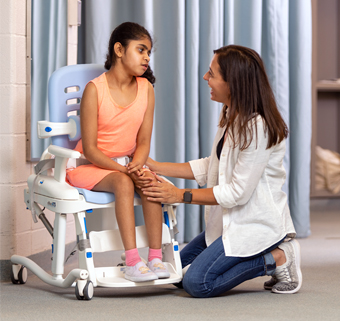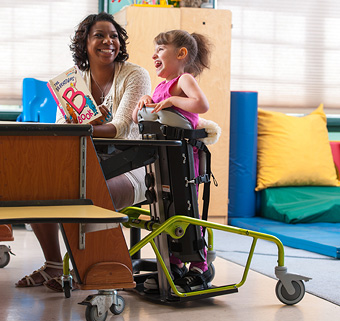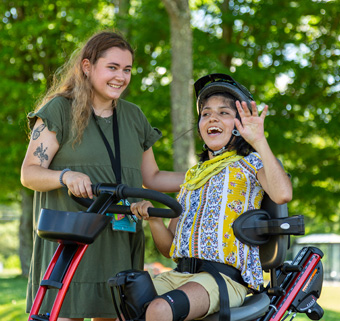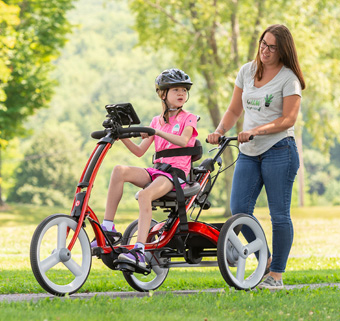The On Time Mobility Framework
Mobility Equity for Young Children with Disabilities
| May 2023 “ON Time Mobility” is a term coined to reflect best practices towards providing hours of daily, active mobility opportunities to young children with disabilities, to foster exploration, motor development and socialization. The authors of a recent special communication, ON Time Mobility: Advocating for Mobility Equity, maintain that mobility is a human right which begins in the first year of life.1,2 While many clinicians agree with this position, provisions for this fundamental right are sadly inadequate for the birth to three population. Research tells us that early childhood is the time of most rapid and significant development. This critical time of plasticity of developing systems is driven primarily by movement experience and exploration.3 For young children with disabilities, taking advantage of this window of opportunity to move, learn and grow will improve their functional outcomes and lessen complications in the future. However, children with disabilities between the ages of zero and three are less likely to be actively mobile. This is partly due to inadequate assistive technology for the very young, as well as access and funding issues. Passive mobility is common as young children are easily carried. There is also a lack of evidence-based research to drive interventions and inform practicing clinicians. These factors contribute to suboptimal mobility levels and place the children at risk for maladaptive neuroplasticity. The onus then is on clinicians, researchers, academia and manufacturers to take notice of this critical time of development and provide mobility options to this population that are On Time and appropriate.
“ON Time Mobility” is a term coined to reflect best practices towards providing hours of daily, active mobility opportunities to young children with disabilities, to foster exploration, motor development and socialization. The authors of a recent special communication, ON Time Mobility: Advocating for Mobility Equity, maintain that mobility is a human right which begins in the first year of life.1,2 While many clinicians agree with this position, provisions for this fundamental right are sadly inadequate for the birth to three population. Research tells us that early childhood is the time of most rapid and significant development. This critical time of plasticity of developing systems is driven primarily by movement experience and exploration.3 For young children with disabilities, taking advantage of this window of opportunity to move, learn and grow will improve their functional outcomes and lessen complications in the future. However, children with disabilities between the ages of zero and three are less likely to be actively mobile. This is partly due to inadequate assistive technology for the very young, as well as access and funding issues. Passive mobility is common as young children are easily carried. There is also a lack of evidence-based research to drive interventions and inform practicing clinicians. These factors contribute to suboptimal mobility levels and place the children at risk for maladaptive neuroplasticity. The onus then is on clinicians, researchers, academia and manufacturers to take notice of this critical time of development and provide mobility options to this population that are On Time and appropriate.
The ON Time Mobility Framework
The ON Time Mobility Framework addresses five key principles – Timing, Urgency, Multimodal, Frequency and Sociability. These principles allow therapists to examine current mobility practices in young children with disability alongside advocating for and providing equitable resources.
Timing
Timing recognizes that mobility begins within the first year of life and even current “early” interventions are in fact late and therefore missing much of the critical development period. This is compounded by hesitancy on the part of clinicians and families to explore assistive technology in the very young. The researchers and authors behind ON Time Mobility offer strategies to help inform practice. This starts with clinicians introducing mobility interventions and assistive technology that help young children with disabilities participate in play and social experiences at similar stages to their peers. This also means advocating for technology funding and addressing rules regarding age restricted access to assistive mobility. Equipment manufacturers are part of the picture as well. Sized-down adult equipment is no longer acceptable. Young children below the preschool age need assistive mobility designed and built for their specific mobility requirements, which differ significantly from adult needs.
Urgency
Urgency refers to the critical period of development and neuroplasticity in the birth to three population. This recognizes that mobility is an important driver in cognition, physical development and social well-being; and children need multiple hours of mobility throughout the day for best neuroplastic benefits. However, current practice accepts frequent and prolonged episodes of passive mobility in these children. This ultimately creates situations of learned helplessness and widens the functional gap with their peers. The strategies suggested by the researchers to inform practice for urgency are to consider “Mandatory Mobility” as urgently as we consider “Tummy Time”.2 Introduce it early and provide supportive interventions and technologies for play and exploration. This includes continued education surrounding the positive developmental outcomes of self-initiated movement, both with and without the use of assistive technology. Advocacy for urgency means that families should not have to choose between using funding for a stroller or for a gait trainer. Children and families need both passive and active mobility options for optimal outcomes.
Multimodal
The multimodal principle addresses the use of different types of supportive mobility in a wide variety of environments throughout a child’s day – such as ride-on cars, gait trainers and body-weight harnesses. Traditional practice and technology has focused on walking as the gold standard of mobility, especially in children under five years old.1 But mobility cannot be restricted to one motor skill. Rather, gait training needs to be performed in conjunction with multiple other mobility strategies to achieve the active daily hours necessary for optimal childhood development. This often requires access to multiple mobility devices. The strategies to help inform practice, then, center on advocacy around the disparity of insurance funding only one mobility device for children with disabilities; whereas their peers have access to multiple forms of mobility, from tricycles and scooters to wheeled toys and trampolines. Clinicians should ideally provide motor skill development techniques alongside assistive mobility technology, and continue to educate consumers around the supportive role of assistive technology towards mobility options, access to environments and equity.
Frequency in Real-World Environments
The term frequency recognizes that young children engage in high levels of mobility every day. This gives them multiple opportunities to explore their surroundings, attempt movement and fail, retry and learn movement solutions. In fact, kids learning to walk fall over 100 times per day and mobilize over the length of 46 football fields in the same time-frame. Young children with disabilities need this same chance of self-directed exploration, motor skill trial and error, and frequent mobility in natural settings. Strategies to inform the best practice for frequency include building opportunities for movement and use of mobility technology outside of therapy sessions, and making movement part of everyday life in natural contexts. Where movement is constrained, the use of mobility technology allows children to access everyday environments at home and in the community.
Sociability
Enriching a child’s daily routine and environment with many opportunities for mobility improves participation and advances a child’s social skills. Movement allows young children to interact with family members or meet new friends on the playground, which in turn enhances communication skills and provides context for self-directed mobility. Continued advocacy for inclusion, universal design and accessible playgrounds is an important best practice strategy. Additionally, early intervention therapists can serve as catalysts in creating motor-based play groups with peers and children on their caseload where feasible. And therapists can additionally educate families about the important reciprocal connection between motor skills and communication development. There is no such thing as too much movement in childhood.
Early childhood is a time of rapid and critical development of motor, social and cognitive skills, driven primarily by movement experience. For children with disabilities, taking advantage of this window of opportunity by providing mobility throughout the day can transform their learning, boost motor and social skill acquisition and lessen the physical complications as they age. Therefore, the authors behind the ON Time Mobility framework advocate for mobility equity across all ages, stages and disabilities. The term “ON Time Mobility” implies that until now, young children with disabilities have not received adequate mobility opportunities because of issues with assistive technology access, lack of funding, insufficient awareness and research pertaining to on-time mobility, its implementation and profound positive effect on development. The special communication ON Time Mobility is well worth the read as it outlines how clinicians, researchers, manufactures and families can get involved to create a better future for children with disabilities through on-time mobility.
References
- Sabet A, Feldner H, Tucker J, Logan S, Galloway JC. ON Time Mobility: Advocating for mobility equity. Pediatr Phys Ther. 2022;34:546-50. DOI: 10.1097/PEP.00000000000009392.
- Feldner H, Tucker J, Logan S, Sabet A. Moving beyond ‘early’: Introducing ON Time Mobility as a rights-based framework to support movement experiences in young children with disabilities. Oral presentation at APTA Pediatric Conference, November 2022; Portland OR.
- Morgan C, Fetters L, Adde L et al. Early intervention for children aged 0 to 2 years with or at high risk of cerebral palsy, International clinical practice guideline based on systematic reviews. JAMA Pediatr. 2021;175(8):846-58. DOI: 1001/jamapediatrics.2021.0878






